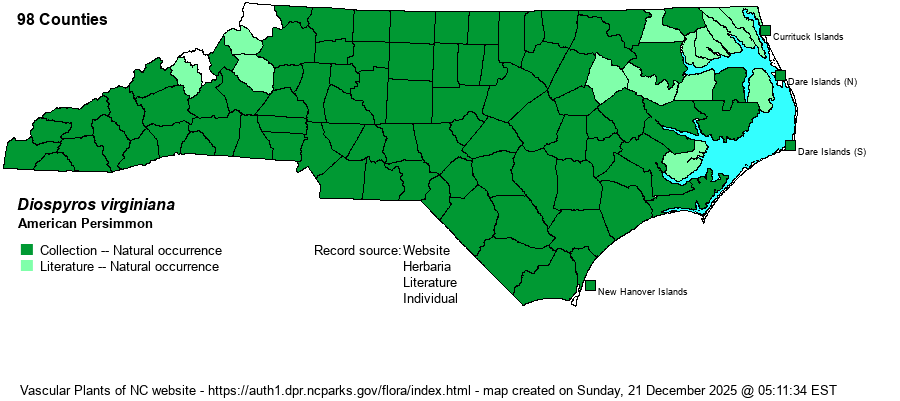| Author | L. | |
| Distribution | Occurs essentially throughout the state, though scarce in the northern Mountains and in the far eastern Coastal Plain.
This is widespread Eastern species, ranging north to CT, southern NY, and southeastern NE, and south to the Gulf Coast.
| |
| Abundance | Common nearly statewide, though much less numerous in the far eastern counties, where it is rare. Scarce in the northern Mountains and may be absent in one or two counties. | |
| Habitat | This species has an extraordinary range of habitats in the state. It is most typical of dry to mesic forests and edges. It certainly occurs in old fields as a successional species. It may also be found in bottomlands and in some sandy places such as pine/oak sandhills. It is often seen along fencerows, as well. |
| Phenology | Flowers in May and June; fruits from September into late fall, persisting into early winter. | |
| Identification | This small to medium deciduous tree needs no introduction; it ranges mostly just to 40-50 feet tall. Despite it being very familiar, many people have trouble identifying it without the characteristic large orange fruit, which are quite conspicuous in the fall. It has ordinary-looking alternate leaves, which are elliptic, entire, and about 3-3.5 inches long and about half as wide. As so many other trees have similar leaves, you should look at the trunk and the buds. The bark is dark gray and conspicuously “blocky”, comprised of small square-shaped “blocks” separated by furrows. And, the buds are very small, black, and rounded, with the scales difficult to see without a hand lens. It also has unique flowers, being small, 4-petaled, and creamy yellow, growing along the stems; petals are very thick and waxy-looking. | |
| Taxonomic Comments | None
| |
| Other Common Name(s) | Persimmon, Common Persimmon, Eastern Persimmon, Possumwood | |
| State Rank | S5 | |
| Global Rank | G5 | |
| State Status | | |
| US Status | | |
| USACE-agcp | FAC link |
| USACE-emp | FAC link |

